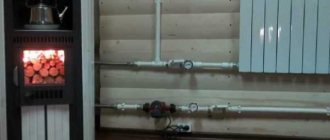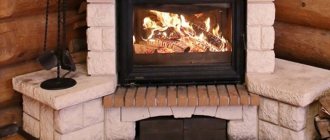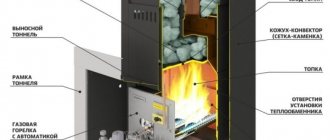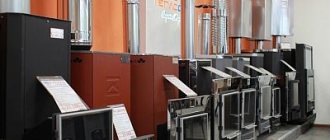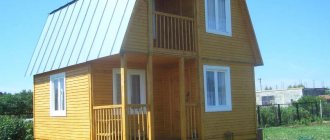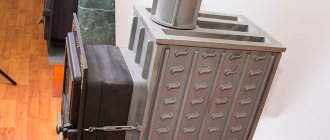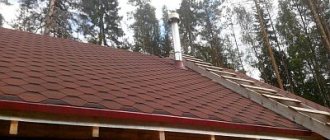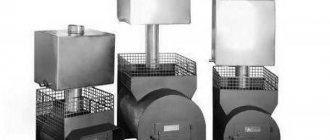Question 1 - How to calculate the power of a sauna stove?
The approximate power of the heating unit for the heated area is given in the plate, but for sauna stoves the manufacturer accommodated the buyer and the stove power parameter included the heated volume that the stove can heat. Therefore, calculating a stove for a bath comes down to calculating the volume of the steam room (the stove is selected based on the steam room). And choose a stove for this volume. As a recommendation, we inform you that it is better to take power with a margin of 2-4 m3 in the larger direction for losses.
That is, for example, the steam room area is 14 m3, it is necessary to take a stove capable of heating 17-18 m3. The parameters of the heated volume are specified in the stove passport. There is no need to take a stove with a large reserve, because the following situation will happen: the stove heats the air very quickly, but does not have time to heat the stones in the heater, and you will simply fill them and you will not get normal steam.
Question 2 - How to heat water in a bath?
I don’t think anyone will argue with the fact that water should be in the bathhouse. The question is how it will appear cold and hot there. The issue of supplying cold water is technical, but how to heat it, a purchased stove can help here. And so, options for heating water from a stove:
Method 1
Immediately buy a sauna stove with a water tank. Usually the tank hangs on the stove either on the left or right side. Before kindling, we pour water into the tank; the water heats up from the hot firebox. The downside here will be the following point - heated water will need to be taken out of the tanks, but it is taken out in two ways: with a ladle on top or from the drain tap at the bottom of the tank.
In the first case, you can splash yourself with boiling water and scald yourself to the tank if there is not enough water left; in the second case, you need a fairly shallow container for the boiling water, which we will drain near the floor from the drain tap in the tank. In general, both the first and second cases are not the most convenient for obtaining hot water, but they work.
Method 2
There are modifications of furnaces with a water circuit, or it is also called a heat exchanger. It is usually attached to the right or left side of the furnace by welding or with special fasteners, it all depends on the design of the furnace.
Next, we connect the pipes to the outlet fittings and bring them to a separate water tank. The advantage of this option is that we place the tank in a place convenient for us and make it convenient for us to remove hot water, even from a tap.
Method 3
Another option is for manufacturers to make a water circuit from chimney pipes, i.e. a water circuit and two outlet fittings are welded onto the starting pipe; the water in it is heated by the heated exhaust gases.
The circuit itself is also connected to an external container of water. The heating efficiency is slightly inferior to the second option, but you definitely won’t be left without hot water.
Another bonus of the water circuit is that you can connect batteries to it to heat the bath. In terms of heating power, the water circuit produces 1.5-3 kW, which is quite enough for two or three radiators. It is also possible to connect a heated floor from the water circuit.
More information about glass in a sauna stove-fireplace
All glasses are silicates in composition. However, the composition can vary , significantly affecting the mechanical properties of the glass. hardening , can affect strength and heat resistance .
Material and characteristics
Let's return to the two main categories of glass that are installed in fireplaces for baths.
Borosilicates
Silicon oxide is the main component of any glass . In addition to it, the composition usually includes soda and limestone . boron oxide is also added to them . Thanks to this additive, glass can withstand temperatures from -80 to 500 degrees.
On a note! Borosilicate begins to soften at 525 degrees.
In addition to temperature inertness, it also has chemical resistance. And yet you should not test it with hydrofluoric and phosphoric acids, as well as heated alkalis. Borosilicate is also resistant to sudden temperature changes.
By the way! Ordinary glass can burst under the influence of temperature, scattering into numerous fragments. Borosilicates do not break like that - they form large fragments without sharp edges.
Quartz glass
This variety can withstand even higher temperatures. It is made from pure quartz - in the form of sand, or the mineral rock crystal and vein quartz. Now the production of artificial silicon dioxide has also been established. The melting point of quartz is 1400 degrees .
Apart from silicon oxide, ordinary quartz glass contains no additives, which is the reason for its high heat resistance and chemical inertness. When the starting components are melted, either transparent glass or opaque glass . The only difference is the presence or absence of gas bubbles, from which the material becomes cloudy and becomes opaque. Of course, only clear glass is placed in a sauna stove with a fireplace.
Characteristics
When choosing glass for a fireplace stove in a bathhouse, the following matters:
- coefficient of thermal expansion . The lower it is, the better. It is especially low for pure quartz glass. Note that the next one depends on this parameter.
For your information! When heated, ordinary glass expands 30 times more than heat-resistant glass. This is a consequence of the presence of alkali metal oxides in it. Oxides of aluminum, boron and silicon, on the contrary, reduce expansion.
- heat resistance The limit to which the fireplace door can be heated without destroying it. A range of 500-550 degrees can be considered acceptable - the glass must withstand these temperatures for a long time . When you buy a stove or door, pay attention to the fact that with prolonged exposure to a higher temperature, the lifespan of the glass becomes significantly shorter. (The dates themselves are indicated in the passport). The manufacturer also indicates the maximum degrees for short-term exposure . Depending on the number of layers in the glass unit, this maximum can be 760 degrees or more than 1000 degrees .
IMPORTANT! In order not to expose the door to overheating, you must not overload the firebox with wood. Remember that a furnace operating at maximum risks not only glass, but also the metal of the body quickly turns into scale. You can also maintain the desired temperature using the draft - by increasing it, you reduce the heating of the door.
- glass thickness. This parameter is important from the point of view of greater or lesser fire hazard. Usually 4-5 mm is taken (this is quite enough), but it is possible to install thicker glass with an eye to greater resistance to flame.
Other characteristics are additional options. For example, glass color, lamination, relief, engraving.
Technologies and popular manufacturers
First, let's introduce an important distinction: tempered glass and heat-resistant glass are not the same thing. These are completely different technologies. In the first case, ordinary glass is taken and quickly heated by more than 600 degrees, after which it is just as quickly cooled by air on both sides.
This option is not suitable for a sauna stove-fireplace . Heat-resistant glass is glass with a certain composition, which was mentioned above. Moreover, the name “ glass ceramics ” is often applied to this variety.
The production of glass ceramics has its limitations. So you have to follow the rule about the impossibility of cutting, which is why the sheets are made in the size that will be used in the finished product.
Let's briefly go through the main technologies.
Lamination - the glass is covered with a protective layer, which, when the base is destroyed, does not allow the fragments to separate from the film.
Tinting is giving transparent glass certain shades. The meaning is mainly aesthetic, but they also say that tinting protects the eyes from excessive brightness.
Thermo-Rite
The most commonly used are warm shades - yellow, orange.
To combat soot that settles on the inner surface of the door, it was invented to apply a thin film of iron oxide, which leads to increased heating and automatic burning of soot.
Increasing strength is a task that has several solutions. There are technologies that use chemical reagents and surface polishing using open flame melting, which ideally smoothes out all possible flaws.
The products of certain manufacturers are most often found on our market:
- Schott Glas is the company that produces the Robax ;
- CrossFire Cerama is a borosilicate .
Installation and maintenance
- Since the door combines metal and glass, the coefficients of thermal expansion of both materials . a heat-resistant cord as a spacer between them .
Remedies for carbon deposits on stove glass
- It is also important to ensure that during installation the metal pressure on the glass is uniform over the entire joint area .
- Do not completely seal the seams , because this may cause the glass to crack.
- As for care, it should be recognized that even the most modern technologies do not eliminate soot on the surface. You'll have to fight on your own. On sale you will find special products to combat soot.
Danger! Do not use abrasives or aggressive cleaning agents under any circumstances . Abrasives leave scratches, and chemicals (for example, chlorine) are harmful not to the glass itself, but to the protective films on its surface.
Advice! If you don’t want to bother with cleaning a lot, choose drier firewood and non-coniferous wood .
Question 3 – Which stove should I buy?
Factories produce three modifications of furnaces: First
— sauna stoves with a closed heater, these are stoves for real gourmet baths; what distinguishes these stoves from others is that the stones in them are located in a closed heater. What this gives: the stones lie as if in an oven, they heat up evenly and when water is applied to them, they produce uniform, finely dispersed steam. The steam is scalding and soft. There are special devices in stock - evaporators, with the help of which water is supplied to the hottest stones located near the firebox, evaporating, it passes through all the stones, breaking into small dispersions and comes out as a dense, scalding cloud of steam.
Second
– sauna stoves with an open heater. The majority of stoves are offered with an open heater. With this option, the steam turns out just as hot and burns just as much. The most important thing is to choose the right stove for the volume of the steam room, why? If we take a stove with a large reserve of volume, we get the following: the air in the steam room will warm up faster than the stones can heat up, and then the stones will not have time to heat up normally and there will be little steam and it will be too wet. A stove properly selected for its volume will provide excellent steam and you can take a steam bath with great pleasure.
Third
— stoves with combined heaters. The design of these stoves has two heaters, closed and open. If in the first and second options the difference is obvious, in this case you will please both the company of amateurs and a professional in the bath business.
Sauna stove-fireplace: which manufacturer to buy from?
Let's return to the option of a purchased stove with a fireplace insert. Almost every large company that produces wood-burning sauna stoves offers customers modifications of models with a transparent fireplace door, for example, the cast-iron stove shown in the illustration from the Russian ]Vesuvius[/anchor].
Wood-burning metal sauna fireplaces, cast iron Vesuvius and others
In another article we have already reviewed various manufacturers of wood-burning stoves for baths; there is no point in repeating ourselves. If you find a stove to your liking, you will probably be able to equip it with a glass door. If you wish (in the same article), you can refer to the results of our survey , the rating of which is formed by readers like you. We are a non-sales information resource, so we stick to the facts.
Let's briefly look at several domestic manufacturers who definitely have the fireplace stoves we need for a wood-burning sauna.
"Feringer"
The company needs no introduction; many people know about such lines as “Steam”, “Classic”, “Malyutka” . All of them are suitable for both Russian and Finnish baths (of course, any metal stove is suitable for a sauna, but not every one is suitable for a Russian bath). Take a closer look at the Feringer models - maybe it will fit).
By the way! The firewood just needs to be well-dried - the stoves of this company do not have a grate , and you need to light the firewood from above, so you can only cope with the task with dry logs.
"Kutkin"
Another name familiar to many. High-quality stoves, however, are not inexpensive solutions. To reduce the cost , you can choose a model that can be tiled yourself. The fireplaces we are interested in in this article are available for each model. The company's stoves are suitable for Russian baths.
"Termofor" and "Teplodar"
Termofor and Teplodar are domestic manufacturers whose names are also well-known. Everyone has stoves with two modes, with closed heaters and, of course, with fireplaces. Check out their websites about the parameters of these ovens.
Actually, we mentioned only domestic companies , because their products are quite competitive and somehow more tailored to Russian realities. This does not mean that foreigners do worse, but we are full of people who like to take a steam bath “the Russian way,” and who better to know the national bathhouse than the Russians? And the prices are reasonable, despite the fact that many companies purchase stainless steel abroad.
Wood-burning metal sauna fireplaces “Vira” and “Vesuvius”
However, the decision is always yours, we only express our opinion.
Question 4 – Type of door or whether we want to have a fireplace for the sauna.
What we are actually talking about: factories make two types of doors - with glass and without glass. As a rule, stoves are now purchased with a remote firebox so that they can be heated from an adjacent room, for example, from a dressing room.
If you buy a sauna stove with a large glass, you will be able to admire the fire in the firebox as if on a real fireplace. By and large, this is aesthetics, but a very pleasant one: you sit after the steam room, drink tea and look at the fire. But this modification increases the cost of the furnace by the price of glass. If the door is without glass, then you won’t be able to admire the fire.
Question 5 - What material should I buy a stove from?
In stores there are stoves made of 3 materials: black steel, stainless steel, cast iron.
In accordance with calculations and experimental results obtained, 6mm black steel lasts as long as 2mm stainless steel. Most stores now have ovens with these thicknesses. Ordinary steel 3 is used as iron for furnaces. But chromium steel with 17% chromium is used as stainless steel. Chrome increases the service life of the stove by 3 times.
In black steel furnaces, it happens that manufacturers weld thicker sheets of iron up to 8 mm into the most thermally loaded areas. And in Feringer furnaces and in stainless steel furnaces, on the walls where the most loaded areas, in some models, additional screens are welded, increasing the service life of the furnaces. And what should you choose in the end – an iron stove for a bath or a stainless steel stove?
Our recommendation is that it doesn’t matter if the black steel is thick and you were actually sold a 2mm thick stainless steel stove, they will last the same amount of time, the only difference is that an iron stove is about 2 times heavier than a stainless steel one.
A cast iron sauna stove will definitely last longer than one made of black or stainless steel. But cast iron is afraid of sudden temperature changes - this is classic. Manufacturers add additives to cast iron during production, which reduces the occurrence of this moment to zero, but still there is a possibility that this will happen, at least psychologically. Our recommendation is to pour hot water on a cast iron stove, the temperature difference will be less, or don’t pour it at all, and the stove will serve you faithfully for a very long time.
Recommendation - How and what to properly heat a stove in a bathhouse, video.
The main point here is the following: you can heat the stove only with what it is designed for. Basically, stoves are designed to fire wood and gas. The combustion temperature of firewood in a bathhouse is 400-600C, both stainless steel and black steel can withstand this temperature for a long period of time and no unpredictable consequences are expected. We do not consider gas, since its combustion temperature is lower than that of firewood.
But if we start heating with pellets, briquettes, or coal, the temperature of the stove changes and the stove may either fail faster or burn out immediately. Why? There are additives in the pills that make them burn longer and brighter, the burning temperature of a briquette is higher than the burning temperature of firewood, and coal generally melts all iron. So it turns out: if you change the fuel, you kill the stove.
So our recommendation is to heat the stove with the type of fuel indicated in the stove’s passport. How to light a stove - chop small chips, put them in the firebox, hide in the chips what you will use to light them... a piece of paper or a special ignition, put larger firewood on them and light the ignition.
At the first stage, to quickly warm up the steam room, it is better to use medium-sized logs, since the smaller the logs, the more heat they release when burning and burn faster, once the steam room is warmed up, you put larger ones in the firebox, they burn longer and maintain the temperature well. To maintain the temperature, you can slightly close the dampers at the air inlet into the furnace and at the gas outlet, but you cannot completely block it. This way the combustion process will be less active.
Fireplace in a bathhouse: what is it and why is it needed?
Well, it’s quite easy to imagine a bathhouse and a fireplace separately. Together, they mean that a stove designed to heat a steam room and create the conditions of your favorite type of bath can, among other things, also be a decoration. To do this, it is enough to abandon the solid metal door to the firebox and replace it with glass.
Video on topic
This is how it might look with a metal stove and a firebox with a fireplace door placed in the rest room, you get a fireplace in a bathhouse:
https://youtu.be/OfH_e4ER6VE
As for such a door, it is a metal frame into which a single or double glazing unit with special heat-resistant glass . The frame can be made of either steel or cast iron . If desired, you can supplement it with forged elements.
However, you should not consider a sauna fireplace stove solely as a decorative element. The practical use of a transparent door is the ability to visually monitor the combustion process.
In addition, the door limits convection from the side of the firebox, preventing heat from escaping with air currents. At the same time, it prevents sparks from entering the room, which increases fire safety . Along with sparks, smoke and soot cannot penetrate.
As an option, you can consider having two heaters in the bathhouse at the same time - a stove in the steam room and a separate fireplace in the relaxation room. This is cost-effective for large baths.
Here you will find everything
In our online store we offer a huge range of sauna stoves. We present stoves of such brands as: Finnish stoves - Harvia, Helo, Kastor, Tilo, domestic manufacturers - Breneran, Termofor, Teplodar, Berezka, Vesuvius, Vulcan, Ermak, Zharstal, Cuirassier, Polytech, Feringer, etc.
We offer you wood-burning and electric sauna stoves of various capacities and designs, with a closed or open heater, with a water tank and an external firebox, accommodating different volumes of stones. All you have to do is choose the appropriate model, and we will always be happy to help you on how to do this. In our online store you can buy almost everything for a bath. If you have any questions, call 8-495-989-40-74 or write
Bathhouse with brick fireplace
It was already mentioned above that freedom in choosing the size and shape of the fireplace door is only possible if the stove is brick, where the portal is made to the taste of the customer. The latter also decides where the firebox will go - into the steam room or into the adjacent room. However, most often a fireplace insert is made precisely if it is located in the room adjacent to the steam room - the relaxation room or (in its absence) in the dressing room.
Stove-fireplace for a wood-burning sauna
Building a brick stove yourself is quite a difficult task. It’s easy to find the order on the Internet, but in order for the stove to fit specific conditions, you need to have experience as a stove maker. Therefore, we advise you to start with something simpler and cheaper . The fireplace door, by the way, is also not cheap, and it weighs a lot. Installing it requires skill, but during operation you will not notice much weight due to the convenient rotating mechanism (this applies to factory models).
Brick sauna stoves with a fireplace (photo source: Yandex)
Video on topic
Watch the video, which shows one of the possible solutions for a bathhouse with a fireplace, with a classic portal, shelf and clock above it. However, the size of the door is small and it is located asymmetrically - this slightly spoils the impression.
